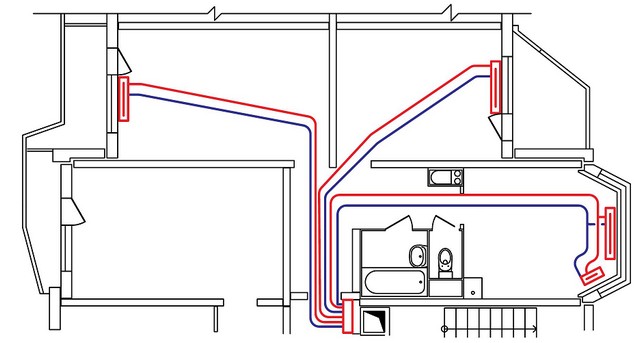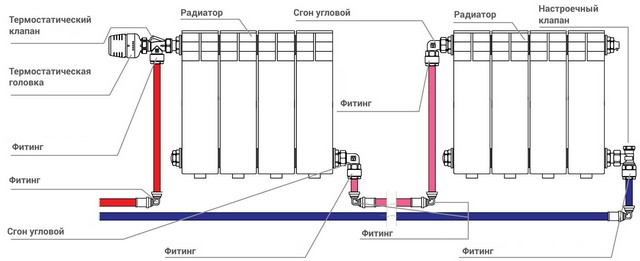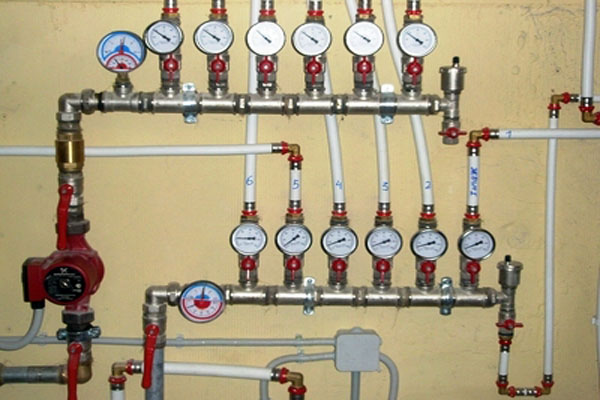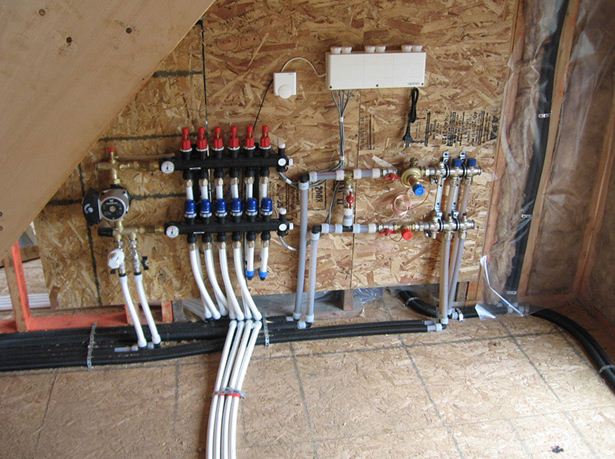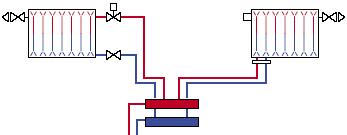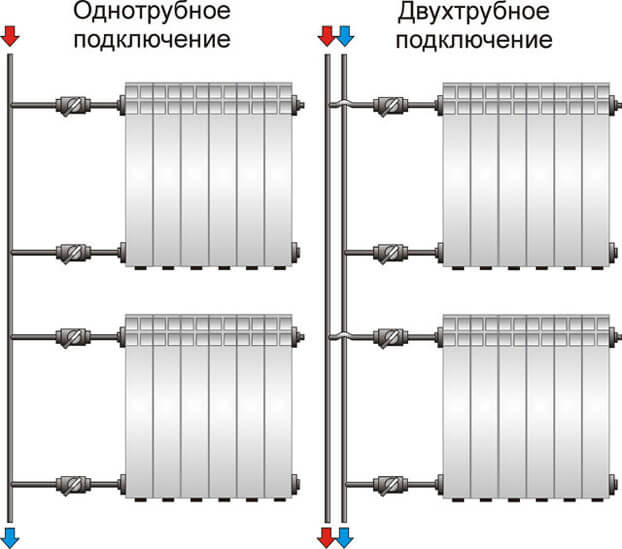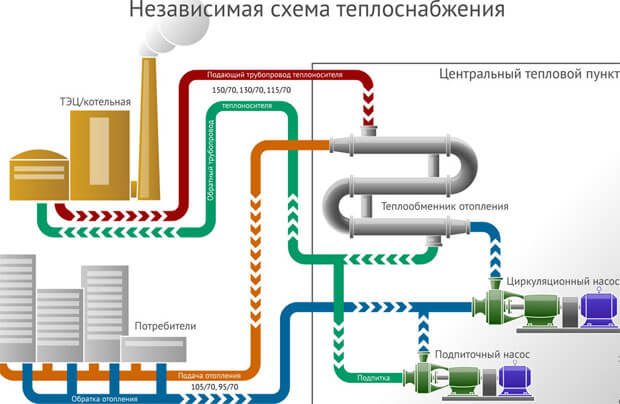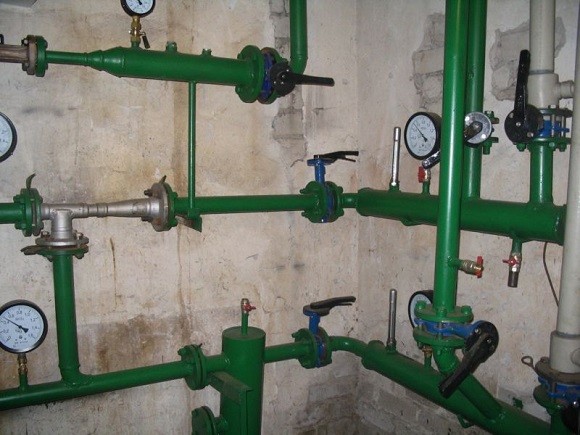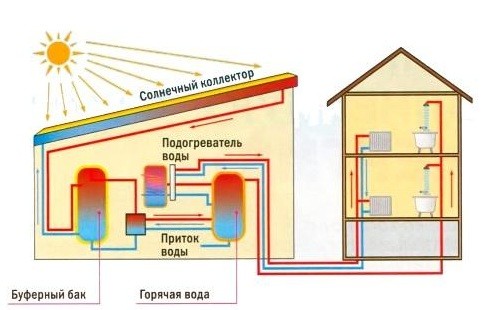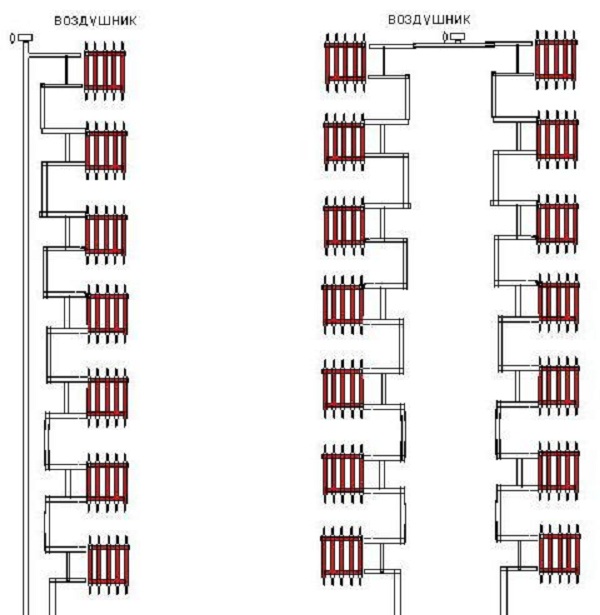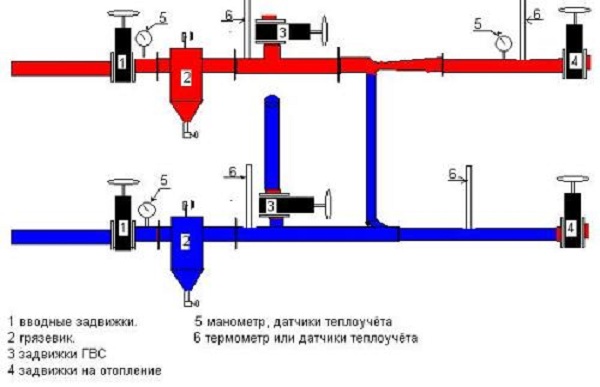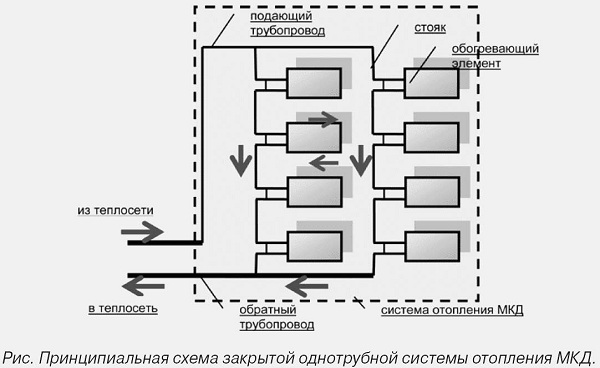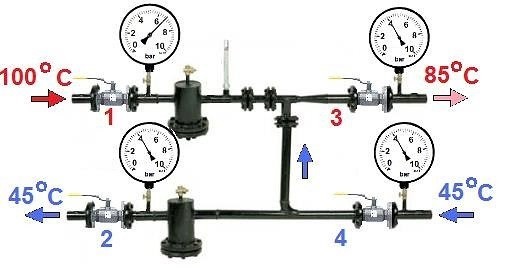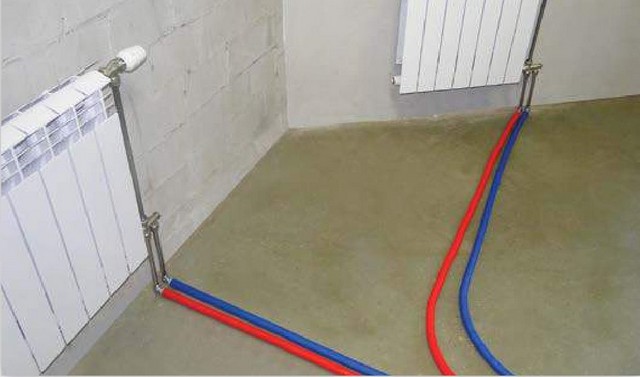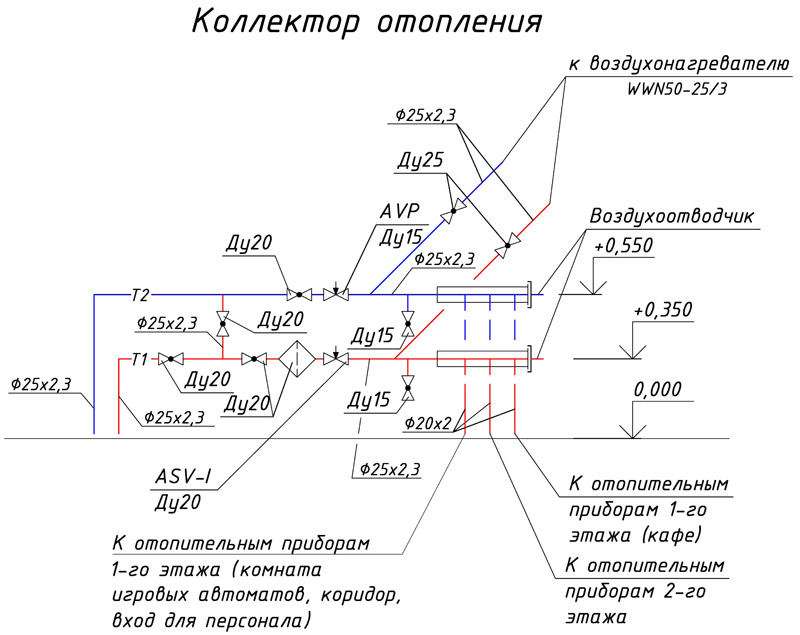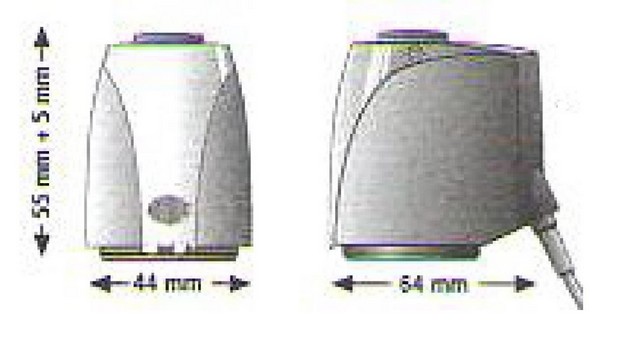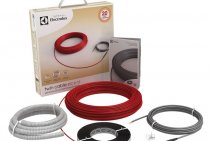Heating standards for apartment buildings heated centrally
These norms are the most "ancient". They were calculated at a time when they did not save on fuel for heating the coolant, the batteries were hot. But the houses were built mainly from materials that were “cold” in terms of heat-saving qualities, that is, from concrete panels.
Times have changed, but the rules remain the same. According to the current GOST R 52617-2000, the air temperature in residential premises should not be lower than 18 ° C (for corner rooms - at least 20 ° C). At the same time, the organization - the supplier of thermal energy has the right to reduce the air temperature by no more than 3 ° C at night (0-5 hours). Separately, heating standards are set for various rooms of the apartment: for example, in the bathroom it should be at least 25 ° C, and in the corridor - at least 16 ° C.
For a long time and at times not without success, society has been fighting to change the procedure for determining heating standards, tying them not to the air temperature in the premises, but to the average temperature of the coolant. This indicator is much more objective for consumers, although unprofitable for the heat supplier. Judge for yourself: the temperature in residential premises often depends not only on the operating system, but on the nature of human life and living conditions.
For example, the thermal conductivity of a brick is much lower than that of concrete, so a brick house at the same temperature will have to spend less heat energy. In rooms such as the kitchen, the heat generated during cooking is not much less than from radiators.
Much also depends on the design features of the heating devices themselves. Say, panel heating systems at the same air temperature will have a higher heat transfer than cast iron batteries. Thus, heating norms tied to air temperature are not entirely fair. This method takes into account the outdoor temperature below 8°C. If this value is fixed for three consecutive days, the heat generating organization must unconditionally supply heat to consumers.
For the middle band, the calculated values of the temperature of the coolant, depending on the temperature of the outside air, have the following values (for convenience of using these values, using household thermometers, the temperature indicators are rounded):
Outside air temperature, °С
Temperature of network water in the supply pipeline, °С
Using the above table, you can easily determine the temperature of the water in the panel heating system (or in any other), using a conventional thermometer at the moment a part of the coolant is drained from the system. For the direct branch, the data of columns 5 and 6 are used, and for the return line, the data of column 7. Note that the first three columns set the outlet temperature of the water, that is, without taking into account losses in the transmission main pipelines.
If the actual temperature of the heat carrier does not correspond to the standard, this is the basis for a proportional reduction in the payment for the provided district heating services.
There is another option with the installation of heat meters, but it works only when all apartments in the house are served by a central heating system. In addition, such meters are subject to an annual mandatory inspection.
Combined heating piping layout
Often, not only one heating device is installed in the room, but several. It is irrational to bring a separate two-pipe loop-branch to each radiator with a collector-beam wiring.It is better to lay a separate branch to each room, which will bypass several heating devices indoors, implementing a dead-end or passing scheme.
Scheme of the combined wiring of the heating system.
Such a system is calculated as a beam system. Branches supplying several radiators with coolant are subject to a separate calculation as dead-end or associated. In modern systems, radiators are equipped with thermal valves (thermostats), which are adjusted by users to different temperatures, based on the current requirements for comfort in the room. The stability of the temperature regime in the room becomes difficult to maintain.
It turns out that it is possible to get rid of instability while simultaneously reducing the cost of connecting radiators by connecting them according to the so-called. "through circuit".
"Pass-through" scheme for connecting radiators.
The thermal valve is installed only on the first radiator in the circuit, regulating the coolant flow for all heaters connected in series. They are perceived as one radiator. Difficulties in balancing will arise with multi-section devices (10 or more sections each).
Radiant heating system
- Radiant heating system - the optimal solution
- Radiation heating: a simple scheme of actions
- Installation like aerobatics
- Not without a circulation pump
Heating systems require a dilemma, especially when it comes to personal preferences of the owners and the individuality of the building that needs to be heated. Those who live in apartment buildings are familiar with the pattern: the higher the floor, the less heat there will be, which means that the degree of comfort will decrease, and the health of the families living there will worsen. The reason is the serial combination of heat exchangers to one, passing and connecting the riser together. The consumption of purchased pipes allows you to save on them, but it is impossible to achieve a uniform temperature in any apartment. The temperature will also vary in the rooms that make up the living space.
It is recommended to combine pipe line wiring from polypropylene and copper material by welding.
Time shows that a radiant heating system is most suitable for balanced temperature control. To designate it, a synonym for collector is used. This modern heating system has proven itself with its performance criteria and safe features for the occupants.
Varieties of beam wiring
Method 1. With forced water circulation
Previously, a beam heating scheme equipped with pumps that pump water was not very popular due to the high cost of parts. But at present, the price of equipment has dropped significantly, and an increasing number of people are opting for it.
The main difference from the gravitational scheme is that the liquid (water or antifreeze) flows from the boiler to the batteries and back not due to the difference in temperature and pressure, but with the help of pumps.
This results in the following benefits:
- there is no restriction on the geometry and number of rooms in housing construction;
- heating can be installed in any area of the premises;
- to connect radiators and collectors, you can use pipes of any length, laid without a slope.
One of the elements of a radiant heating system with forced circulation is a pump
Advice! Despite the fact that the circulation pump can be installed anywhere in the system, it is advisable to do this on the return manifold before the coolant is supplied to the boiler. There, the liquid temperature is the lowest, which positively affects the service life of the equipment.
Method 2. With natural water circulation
In this case, the coolant moves due to gravity: the heated water becomes less dense and lighter, therefore it is forced out to the upper point of the system, after which, as it cools, it flows through the collectors and radiators, and then returns to the heater.
Gravitational beam heating system has the following features:
- During installation, an open expansion tank is required, installed at the highest point. It compensates for the thermal expansion of the coolant and prevents an increase in internal pressure in pipelines.
- A radiant heating network with natural circulation does not require the installation of expensive electrical equipment, which significantly reduces the estimated cost of work.
- Heating with natural circulation is completely non-volatile. Even with a power outage, which often happens in summer cottages or in rural areas, you will not be left without heat.
Gravity heating system does not use pumps
Design features of the heating circuit
In chain heating behind the elevator unit there are different valves. Their role cannot be underestimated, since they make it possible to regulate heating in individual entrances or in the whole house. Most often, the adjustment of the valves is carried out manually by employees of the heat supply company, if the need arises.
In modern buildings, additional elements are often used, such as collectors, heat meters for batteries and other equipment. In recent years, almost every heating system in high-rise buildings is equipped with automation to minimize human intervention in the operation of the structure (read: “Weather-dependent automation of heating systems - about automation and controllers for boilers with examples“). All the described details allow to achieve better performance, increase efficiency and make it possible to distribute heat energy more evenly throughout all apartments.
Hot water supply in heating systems
DHW in multi-storey buildings is usually centralized, while the water is heated in boiler rooms. Hot water supply is connected from heating circuits, both from single-pipe and from two-pipe. The temperature in the hot water tap in the morning is warm or cold, depending on the number of main pipes. If there is a single-pipe heat supply for an apartment building with a height of 5 floors, then when a hot tap is opened, cold water will first flow out of it for half a minute.
The reason lies in the fact that at night rarely any of the residents turn on the tap with hot water, and the coolant in the pipes cools down. As a result, there is an overuse of unnecessary cooled water, since it is drained directly into the sewer.
Unlike a single-pipe system, in a two-pipe version, hot water circulates continuously, so the problem with hot water described above does not arise there. True, in some houses, a riser with pipes - heated towel rails, which are hot even in the summer heat, is looped through the hot water supply system.
During the summer period, the entire system that provides central heating in an apartment building is tested. Utilities carry out current and major repairs on the heating main, while turning off certain sections on it. On the eve of the upcoming heating season, the repaired heating main is re-tested (for more details: “Rules for preparing a residential building for the heating season“).
Features of heat supply in an apartment building, details on the video:
Pressure drop
In order for the heating system to perform its functions normally, the pressure drop, which is the difference between its values on the supply and return, must be a certain and constant value. In numerical terms, it should be in the range from 0.1 to 0.2 MPa.
A downward deviation of the parameter indicates a failure in the circulation of the coolant through the pipes. Fluctuation in the direction of increasing the indicator - about airing the heating system.
In any case, you need to look for the cause of the change, otherwise individual elements may fail.
If the pressure has dropped, then check for leaks: turn off the pump and observe changes in static pressure. If it continues to decrease, then they look for the place of damage by sequentially removing different sections from the scheme.
In the case when the static head does not change, then the reason lies in the equipment malfunction.
The stability of the operating pressure drop initially depends on the designers, on their hydraulic calculations, and then on the correct installation of the line. The heating of a high-rise building is functioning normally, during the installation of which the following points are taken into account:
- The supply pipeline, with rare exceptions, is at the top, the return at the bottom.
- Spills are made of pipes with a cross section of 50 to 80 mm, and risers and supply to batteries - from 20 to 25 mm.
- Regulators are embedded in the heating system in the bypass line of the pump or the jumper connecting the supply and return, ensuring that even with sudden pressure drops, air does not appear.
- Shutoff valves are present in the heat supply scheme.
There are no ideal operating conditions for a heating system. There are always losses that reduce pressure indicators, but still they should not go beyond the regulated Building Regulations and Rules of the Russian Federation SNiP 41-01-2003.
The concept of the heating rate can be completely different for two situations: when the apartment is heated centrally, and when autonomous heating is installed and functioning in the house.
Centralized heating in the apartment
Features of heating an apartment in a multi-storey building
After carefully reading the instructions for the heating scheme of a multi-storey building, you can make sure that all norms and requirements must be observed without fail.
In any apartment there should be appropriate heating, raising the air temperature to 22 degrees and keeping the humidity in the room within 40%.
The scheme of the heating system of an apartment building provides for its competent installation, thanks to which it is possible to achieve such a temperature and humidity.
In the process of designing such a heating scheme, highly qualified specialists should be invited who will be able to qualitatively calculate all the necessary aspects for work. They must also ensure that uniform pressure of the coolant is maintained in the pipes. Such pressure should be the same both on the first and on the last floor.
The main feature of the modern multi-storey building heating system is manifested in work on superheated water. This coolant comes from the CHP and has a very high temperature - 150C with a pressure of up to 10 atmospheres. Steam is formed in the pipes due to the fact that the pressure in them rises greatly, which also contributes to the transfer of heated water to the last houses of the high-rise building. Also, the heating scheme of a panel house assumes a considerable return temperature of 70C. In the warm and cold seasons, the water temperature can vary greatly, so the exact values \u200b\u200bwill depend solely on the characteristics of the environment.
As you know, the temperature of the coolant in the pipes that are installed in a multi-storey building reaches 130C. But such hot batteries in modern apartments simply do not exist, and all due to the fact that there is a supply line through which heated water passes, and the line is connected to the return line using a special jumper called "elevator node".
The heating system of a multi-storey building, the scheme, which is the most efficient, in any case, should provide for the presence of an elevator unit.
Such a scheme has many features, since such a node is designed to perform certain functions. The coolant with a high temperature must enter the elevator unit, which performs the main function of heat exchange. The water reaches a high temperature and with the help of high pressure passes through the elevator to inject the coolant from the return. In parallel, water is also supplied from the pipeline for recirculation, which occurs in the heating system.
Such a heating scheme for a 5-storey building is the most efficient, therefore it is actively installed in modern multi-storey buildings.
This is how heating in an apartment building looks like, the scheme of which provides for the presence of an elevator unit. On it you can see many valves that play an important role in heating and uniform heat supply.
As a rule, such valves are manually adjusted without problems. But the adjustment of valves, as a rule, is carried out only by highly qualified specialists who work in public services.
When installing heating in an apartment building, the scheme should also provide for the presence of such valves at all possible points so that in the event of an accident it is possible to shut off the flow of hot water or reduce pressure. This is also facilitated by various collectors and other equipment that operates in automatic mode. Therefore, this technique provides greater heating performance and efficiency of its supply to the last floors.
A large number of multi-storey buildings have one-pipe heating systems, which involve lower wiring. It is worth noting that the design of the high-rise building itself and many other aspects that may affect the heating scheme are also taken into account.
Depending on these aspects, the coolant can be supplied both from top to bottom and from bottom to top. Some houses have special risers that act as a supplier of hot water up and cold down. Therefore, in many apartments, cast-iron batteries are installed, which are very resistant to temperature extremes.
Features of the heating system of apartment buildings
When installing heating equipment in multi-storey buildings, it is imperative to comply with the requirements established by the regulatory documentation, which includes SNiP and GOST. These documents state that the heating structure should provide a constant temperature in the apartments within the range of 20-22 degrees, and the humidity should vary from 30 to 45 percent.
Despite the existence of standards, many houses, especially old ones, do not meet these indicators. If this is the case, then first of all you need to do the installation of thermal insulation and change the heating devices, and only then contact the heat supply company. The heating of a three-story house, the scheme of which is shown in the photo, can be cited as an example of a good heating scheme. To achieve the required parameters, a complex design is used that requires high-quality equipment. When creating a project for the heating system of an apartment building, specialists use all their knowledge to achieve an even distribution of heat in all sections of the heating main and create a comparable pressure on each tier of the building. One of the integral elements of the work of such a design is the work on a superheated coolant, which provides for the heating scheme of a three-story house or other skyscrapers.
How it works? Water comes directly from the thermal power plant and is heated to 130-150 degrees. In addition, the pressure is increased to 6-10 atmospheres, so the formation of steam is impossible - high pressure will drive water through all floors of the house without loss. The temperature of the liquid in the return pipeline in this case can reach 60-70 degrees.Of course, at different times of the year, the temperature regime can change, since it is directly related to the ambient temperature.
Providing heat to apartment buildings centralized heating system
As is known, a significant share of the housing stock is provided with heat centrally. And, despite the fact that in recent years more modern heat supply schemes have appeared and are being introduced, central heating remains in demand, if not among the owners, then among developers of multi-apartment housing. However, it should be noted that many years of foreign and domestic experience in the use of such a heating option has proved its effectiveness and the right to exist in the future, provided that all elements are trouble-free and of high quality.
A distinctive feature of such a scheme is the generation of heat outside the heated buildings, the delivery of which from the heat source is carried out through pipelines. In other words, centralized heating is a complex engineering system distributed over a large area, providing heat to a large number of objects at the same time.
Pressure in the heating system of a multi-storey building
The following factors influence the actual pressure value:
- The condition and capacity of the equipment supplying the coolant.
- The diameter of the pipes through which the coolant circulates in the apartment. It happens that wanting to increase the temperature indicators, the owners themselves change their diameter upwards, reducing the overall pressure value.
- The location of a particular apartment. Ideally, this should not matter, but in reality there is a dependence on the floor, and on the distance from the riser.
- The degree of wear of the pipeline and heating devices. In the presence of old batteries and pipes, one should not expect that the pressure readings will remain normal. It is better to prevent the occurrence of emergency situations by replacing your old heating equipment.
How pressure changes with temperature
Check the working pressure in a high-rise building using tubular deformation pressure gauges. If, when designing the system, the designers laid down automatic pressure control and its control, then sensors of various types are additionally installed. In accordance with the requirements prescribed in the regulatory documents, control is carried out in the most critical areas:
- at the coolant supply from the source and at the outlet;
- before the pump, filters, pressure regulators, mud collectors and after these elements;
- at the outlet of the pipeline from the boiler room or CHP, as well as at its entry into the house.
Please note: 10% difference between standard working pressure on the 1st and 9th floor is normal
About the centralized heating system and schemes for its implementation
The CSO (central heating system of a multi-storey building) has never been particularly efficient - on the way to the consumer, up to 30% of the heat is lost, which the consumer pays for. Therefore, many apartment owners are abandoning the CSO in favor of an autonomous system due to its greater efficiency and cost-effectiveness. But how does centralized heating of apartments work, and can it be improved?
The system of piping around the house is schematically very complex, plus the supply of pipes to a residential building, and the distribution of heat in the districts. In just one single house, hundreds of valves, taps, drains, fittings, distributors and flanges are included in the scheme, which work on the central equipment - the elevator unit that regulates the distribution of heat throughout the house.
Schemes for supplying coolant to a separate apartment from the elevator unit are different. So, the scheme with a bottom spill uses the principle of supplying the coolant in the direction from the bottom up. Those who live in Brezhnevka, Khrushchev and Stalinka houses know how it works.
In a multi-storey building with such a scheme for supplying a coolant, the supply and return pipes are mounted around the perimeter of the house, starting from the basement, and act as jumpers between the heat pipes. Such a scheme is a closed cycle with the beginning and end in the basement of the house. The top point of this piping is the highest flat(s) in the house.
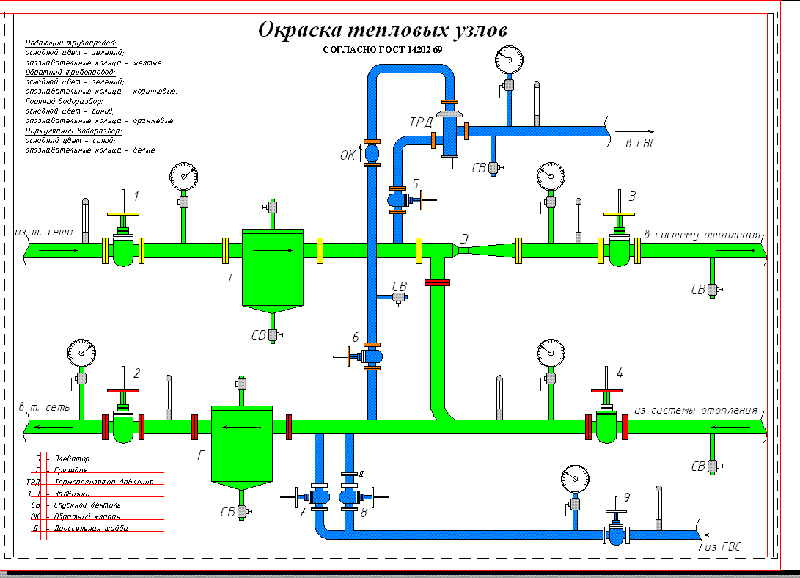
- The main drawback that this heating system in an apartment building did not get rid of was the mandatory air release at the highest point of the wiring when the system was started. To do this, use Mayevsky cranes or conventional valves. If the air is not released, then the air lock will necessarily block the system at some arbitrary point, closing the heating of the entire house.
- Another minus of the bottom spill scheme is that half of the house is heated by hotter batteries (from the coolant supply pipe), and the second half of the residents receive a slightly cooled coolant (for the most part from the return), and nothing can be done about it. The temperature difference is especially noticeable on the lower floors of the house.
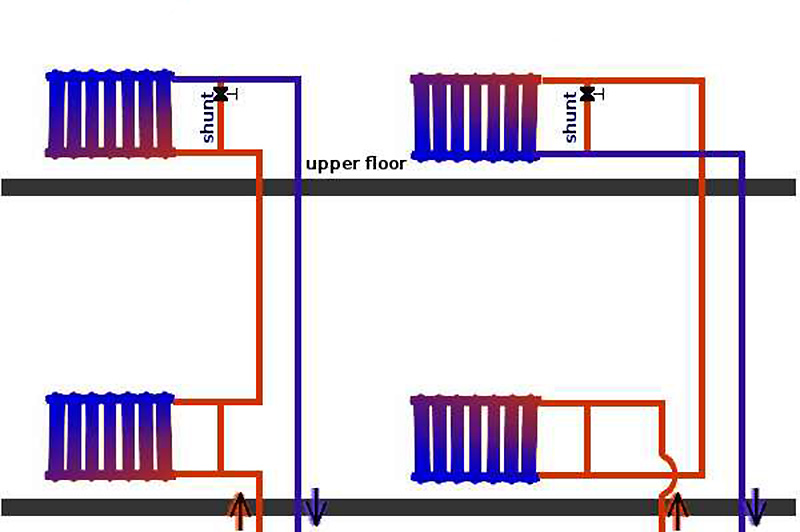
Important: For those who are still connected to the central heating system and live on the top floor, do not transfer the Mayevsky crane to the attic so that there are no questions, including financial ones, to you from your housing and communal services. Moreover, the attic is not heated, and the pipes can simply freeze and break.
Top pouring is used for taller houses, starting with nine-story buildings. The coolant supply pipe does not enter the apartments, but is carried out to the technical floor - the topmost one, immediately after the last residential one. On this floor there is an expansion tank, an air valve and valves, with the help of which the necessary risers are turned off in case of need - repair or an accident. When organizing a scheme with top filling, heat is distributed more evenly among the apartments, and distribution does not depend on which floor and which entrance the apartment is located on. Such a heating system in an apartment building, the scheme of which is shown in the figure below, is optimal for high-rise buildings.
There is only one drawback of the scheme: after being transported through all floors of an apartment building, the coolant reaches the last branch of heat distribution cooled down, and heat transfer in the apartment can be increased only by increasing the number of sections in the radiators throughout the apartment.
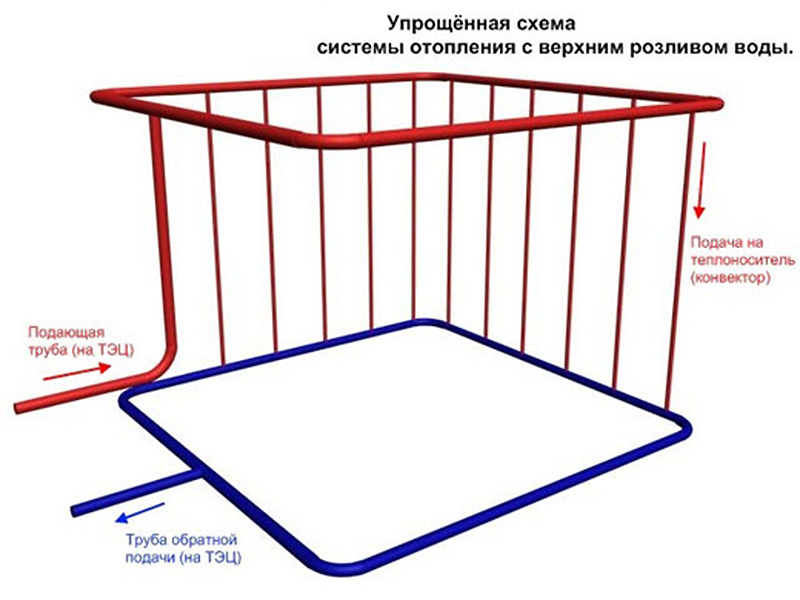
The regulation for the provision of central heating services in an apartment building stipulates temperature limits in the apartment: during the heating season, the temperature in residential premises should not be less than +20 0 С, and in the bathroom or in the combined bathroom +25 0 С. For the kitchen, the temperature threshold is lower - up to +18 0 C, since it is almost always heated additionally - by an oven (gas or electric) for cooking.
Important: all temperature requirements apply to apartments in the center of the house. For corner and side apartments, the temperature should be 3-5 0 C higher
Experts working in this field argue that central heating in an apartment building is becoming obsolete, and the era of mini-boiler rooms and autonomous heating systems is coming. But until that happens, you have to choose.
General requirements for the installation of beam wiring
With collector-beam wiring, the method of laying pipes in the floor in a screed is common, the thickness of which is 50-80 mm. Plywood is laid on top, covered with a finishing floor covering (parquet, linoleum). Such a thickness of the screed is quite sufficient for the free "embedding" of the intra-apartment (intra-house) radiant wiring of the heating system. It is possible to lay pipes outside along the walls under decorative plinths, which inevitably increases the length of the pipelines.Known options for laying pipes for beam wiring in the space of a false (suspended) ceiling, in strobes.
Connecting radiators with a collector-beam scheme.
Metal-plastic or cross-linked polyethylene pipes (PEX-pipes) are used, laid in a corrugated pipe or in thermal insulation. PEX pipes have an undoubted advantage here. According to SNiP, only inextricable joints can be "embedded" in concrete. PEX-pipes are connected by means of tension fittings related to inextricable connections. Metal-plastic pipes use compression fittings with union nuts. To “monolichize” them means to violate the SNiP. Each detachable pipe connection must be accessible for maintenance (tightening).
Even without fittings, not every metal-plastic pipe is uniquely suitable for laying in a floor screed. Manufacturers' products suffer from a serious defect: layers of aluminum and polyethylene delaminate under the influence of repeatedly changing coolant temperature. After all, metal and plastic have different coefficients of volumetric expansion. Therefore, the adhesive connecting them should be:
- internally strong (cohesive);
- adhesive to aluminum and polyethylene;
- flexible;
- elastic;
- heat resistant.
Not all adhesive compositions of even well-known European manufacturers of metal-plastic pipes satisfy these requirements, which delaminate over time, the inner layer of polyethylene in such a pipe “collapses”, reducing its cross section. The normal operation of the system is disrupted, and it is almost impossible to find the place of the malfunction - they usually “sin” for malfunctions of thermostats, pumps and other products with moving parts.
In the light of the foregoing, we recommend that readers pay attention to metal-plastic pipes from VALTEC, which uses an American adhesive from the DSM concern, which ensures the strength of the metal / plastic connection, adhesion and the complete absence of delaminations.
Radiant heating unpretentious scheme of actions
Scheme of the heating collector.
The radiant heating system of this variety is especially suitable for permanent people who prefer stability in everything. They definitely do not neglect the correct adjustment of the temperature component. In pursuit of this goal, they install a pair of collectors with their own hands. They will be adjacent to the required number of appliances for heating and underfloor heating. In this case, their main functions will be to collect water and divide this coolant according to the created heating system. A pair of collectors is securely fixed in the cabinet.
This radiant heating system assumes its own individual style of combining the pipeline - with loops. Each radiator is combined with a distribution manifold at home. It is better to hide the pipelines coming from it to all fixed heating devices in a reliable floor or in walls, concealing them under baseboards.
It is gratifying that this system is universal to a certain extent. If you need to replace not all, but only part of the heating devices, then this is easy to do with your own hands. There is no need to disable the entire system for this.
Automatic collector-beam system
The supply of coolant to radiators connected by beam wiring can be made automatically adjustable. In this case, a small-sized electromechanical servo drive is installed on the thermal valves of the return manifold (item 2 in the figure “Complete manifold block”) instead of a plastic cover for manual control (position 4 in the figure “Complete manifold block”), connected by a cable to an analog thermostat or controller. Radiators are connected to heating pipes without fittings at all (ball valves can be installed).
Thermal valve actuator dimensions.
Such a scheme has an increased capital cost, while providing an increased level of comfort.the air temperature desired by the user can be set from the control panel of the room thermostat, the signals of which are processed by servomotors on the thermal valves of the “return” collector. The system can be controlled by the so-called chrono-thermostat, which provides the user with the opportunity to set a temperature control program for a week with differentiation by day of the week and time of day.
Conclusion
The heating system with collector-beam piping provides the user with the possibility of hydraulic balancing and individual adjustment of the operating modes of heating devices. Some increase in the length of the pipes with beam wiring is obviously compensated by a decrease in their diameter and ease of installation.
How to implement alternative heating of a private house
Two-pipe heating system of a private house - classification, varieties and practical design skills
Single-pipe and two-pipe heating distribution in a private house
